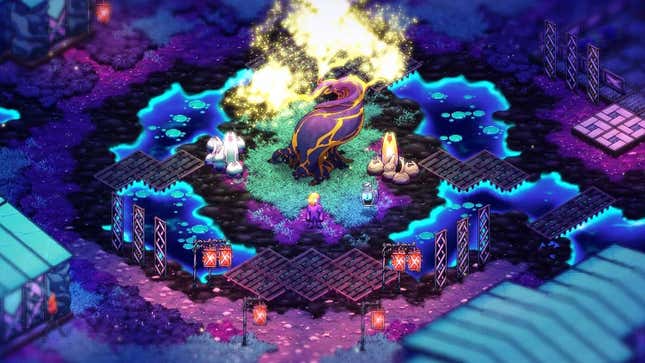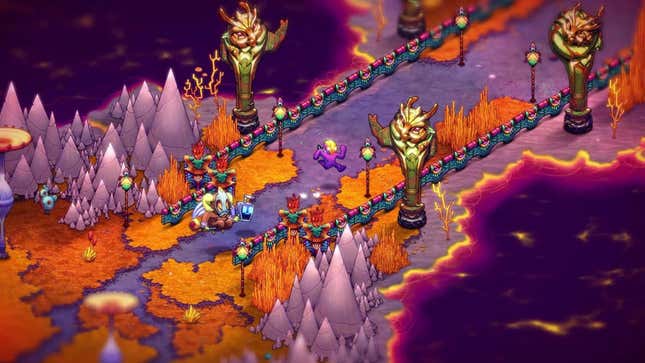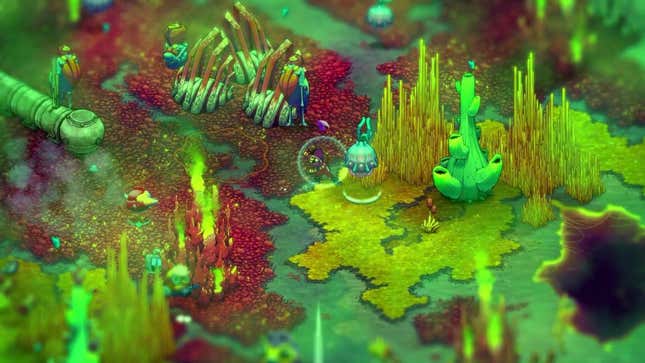
Crashlands 2 is one of those completely brilliant games that can entirely consume your spare time for weeks. It’s an open-world craft-heavy RPG in which you charge around an alien planet, beating up the local flora and fauna, in order to gather their parts to build more effective means of beating up the local flora and fauna. Along the way, there’s the most astonishingly intricate storyline, a vast cast of bonkers characters, and a kerjillion (I counted) items to craft.
OK, so not much about the above perhaps sounds fantastically original, and sure, I get that. But what makes Crashlands and its recent sequel stand out from the crowd is that it plays like an action-RPG. Combat is very lively, all about getting in a hit, dashing and rolling, throwing in a bomb, mixing up ranged and melee combat, and all from a comfortable isometric view.
Each enemy type, of which there are approximately infinity, requires a unique tactic, often with two or three of them getting mixed up in a brawl at the same time. That latter situation is the best, because they all want to fight each other as much as they want to kill you, so luring them toward each other can create a splendid showdown, with you lobbing in explosives from the sidelines. There’s rarely a moment when you aren’t whacking at something, whether it’s rocks, plants or vicious creatures, usually while running to your next quest or destination.
I really encourage you to play both games, but I’m focusing on Crashlands 2 today because it came out just last month, and it’s occupied so many of my evenings and spare moments that it just feels silly not to share that with you. It’s one of those games I’m playing purely for pleasure, looking forward to after a busy day of playing other games, and not even thinking about how I could turn it into work (even though I now accidentally have). I’ve accidentally stayed up far too late far too many nights over the last couple of weeks, thinking I’ll just get another couple of quests ticked off, get the ingredients for the next dagger upgrade, and see about clearing out that one robot base, and then discovering it’s somehow 2 a.m. and I have the school run in the morning.
You play as Flux Dabes, an intergalactic trucker who has been screwed over by her corporation, and finds herself (in both games) dumped on an alien planet—Woanope—without the means to leave. She’s once again accompanied by Juicebox, a floating, um, robotic juice carton, who provides color commentary and endless wry remarks, and the two become intricately involved in the lives of the local intelligent lifeforms and their battle against the same corporation you’ve recently quit.

What’s more extraordinary than anything else about these games is their size. They are so, so big. As you play, your explorable area endlessly grows, gated by the strength of more distant enemies and occasionally by the need to develop means of traveling that you’ve yet to craft. In Crashlands 2, you also build a little home for yourself and your inventive companions packed with research benches for them to work at, where they tirelessly dream up new devices, weapons, nets, bombs, fertilizers, staffs, fishing rods, helmets, wall types, baits, armors, and pieces of decor for you to craft from the billions of items that drop when you hit stuff. Plentiful teleporters mean the ever-growing scale doesn’t become too daunting, and the constant sense of progress is unrelentingly rewarding.
I really cannot express to you how large this game is. I remember in 2016's Crashlands, thinking I was about to end the game, before discovering I had only explored one landscape out of two. Something similar happened in the sequel, when after a packed 15 hours or so of playing I was wrapping up the storyline, defeating a tougher boss, and thinking I was about to roll credits, only to discover it was teasing me, I wasn’t even halfway. And, crucially, I was delighted! I wasn’t ready for it to be over.

I think a large part of why I didn’t want it to be done, even though I’d gone through a satisfying arc that’d be easily worth the entry fee, is because of the game’s constant positive feedback loop. You’re always progressing, always ticking off something from one of its many lists, and each time experiencing a meaningful difference. Beefing up your knuckles weapon, and then equipping it with a bunch of trinkets and buffs that complement it, means thwacking a tricky enemy is going to be much easier. Boosting your HP with new armor makes you feel so much tougher. Crafting a new workbench suddenly opens up your opportunities in multiple directions. More means more fantastically animated enemy types, more silly story, more quests to complete, more locations to uncover, more boxes to tick and items to craft and progress progress progress.
Flaws? Well, weirdly—given how much love is poured into it—I would say the writing. It’s really good! It’s just that there’s far too much of it. Conversations to get a new quest can end up going on for 20, 30 exchanges of speech-bubble text, and while it’s all superbly written and often very funny, I find myself frustrated by just wanting to know what I’m supposed to be doing next. I have, I confess, committed the cardinal sin of clicking through it all and then just checking the quest log. I don’t want to! But honestly, Crashlands 2 is so wildly overwritten. It needed a detached, heartless editor to cut swathes from it, keep the great gags, and get to the point.
But when that’s my major complaint about such a detailed and expansive game, you know it must be doing an awful lot right. And all of this in a paid-for game that has no in-app purchases or extra fees. These games could be monetized to utter misery, and instead they don’t even dip a toe in that mire.

This does make Crashlands 2 that most unusual of games: a mobile app that costs money up front. There’s a PC version too, and it’s splendid, but it’s pricier at $25. (And totally worth it. There’s at least 35 hours of game here!) The iOS/Android version is $10, despite being the same game, and while that discrepancy always feels odd, it’s important to note that mobile prices are just a different market: choosing to charge customers at the point of purchase, rather than exploit them ever-after, can be devastating for attention. As such, rather than the million-plus downloads a game like this would get if it were “free-to-play,” it currently sports “5K+” downloads on Android. I really want to express how this is worth every penny, for me one of the most essential games on my tablet, and how important it is to support excellent games that use non-exploitative payments.
I really don’t know why this isn’t on Xbox or PS5. It’d be the perfect couch game, absorbing your late evening hours, perfectly paired with a light-hearted podcast. But it still sits so well on my Android tablet, one of those games (like the very different Gems of War) that makes the device feel worth owning. Crashlands 2 is such a treat, no matter which device you play it on, a game that feels so endlessly generous and involved.
Crashlands 2 is on Steam, iOS and Android, created by the unimprovably named small indie team Butterscotch Shenanigans.
.

